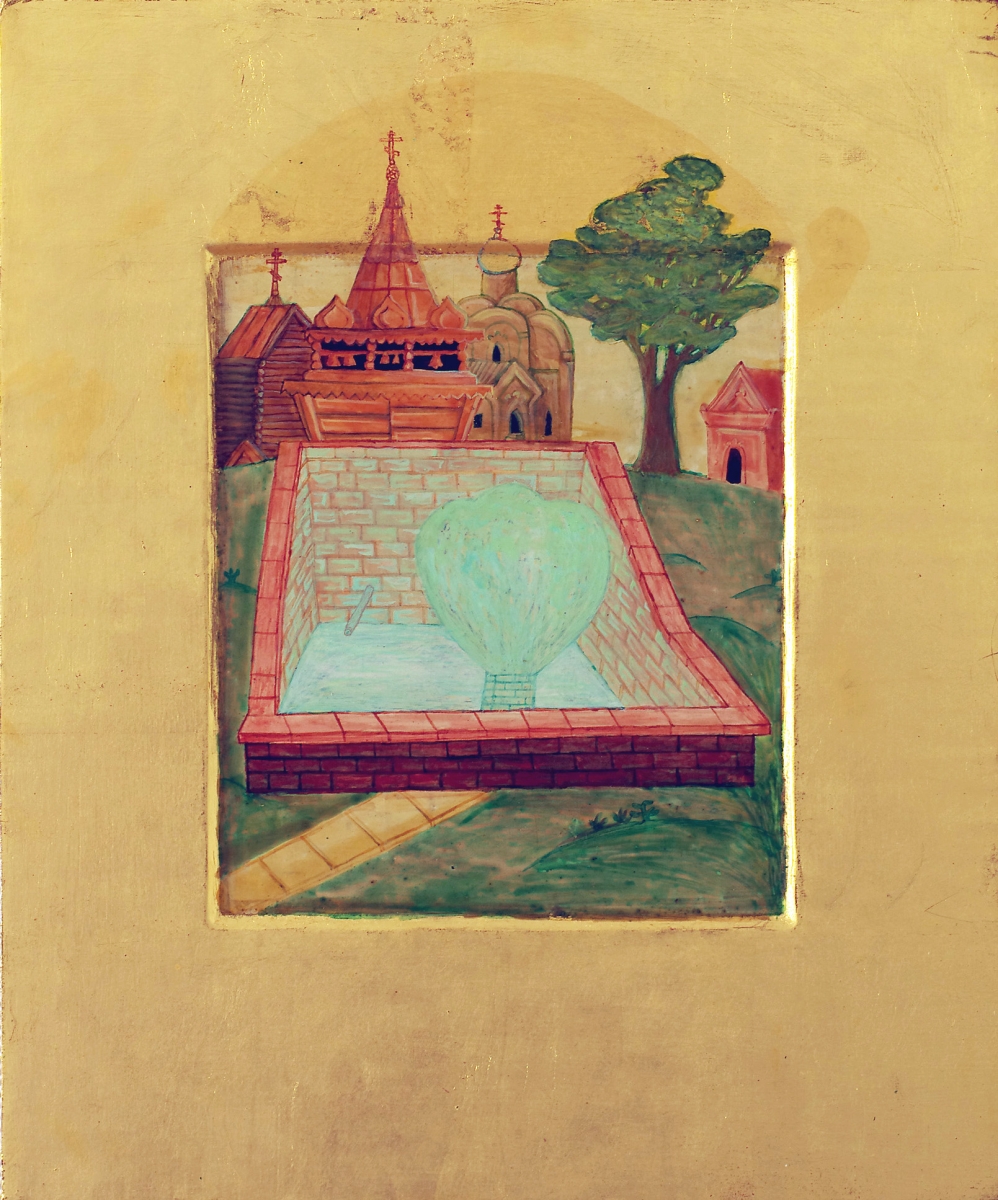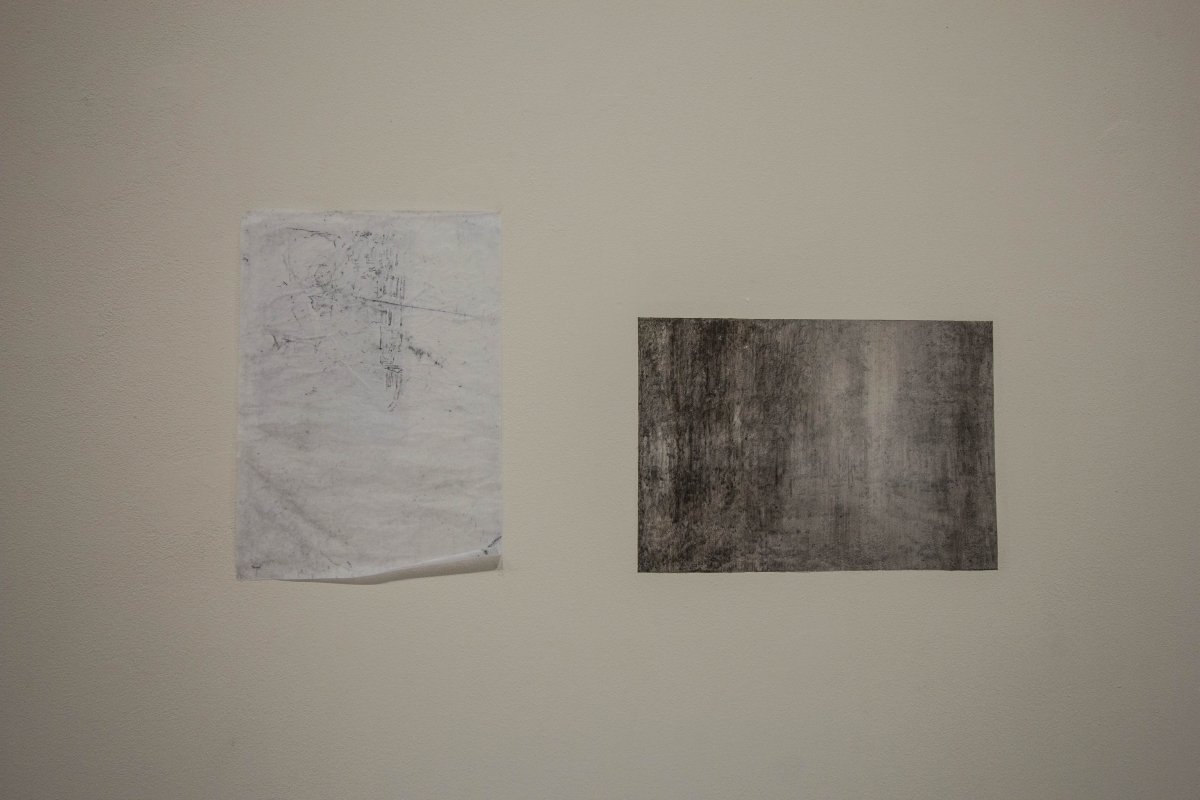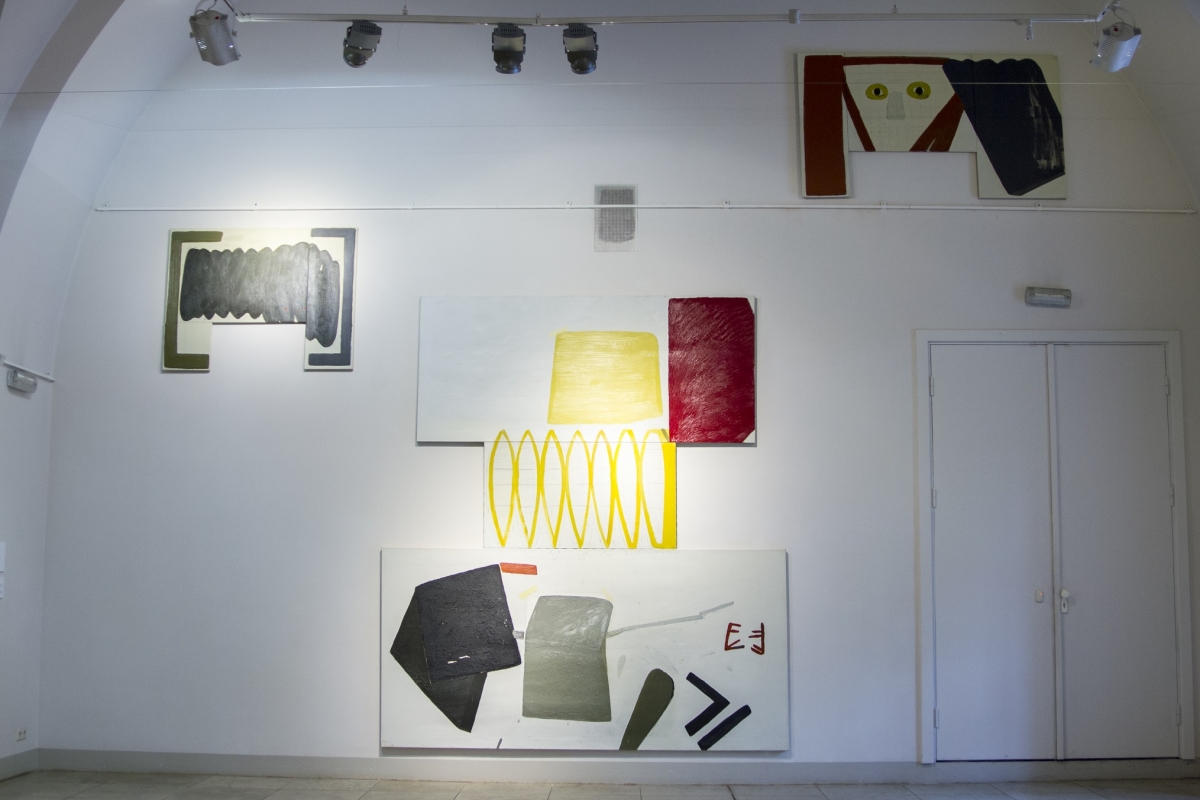
Linda Vidgorčika “Untitled [on an island]”. Oil, acrylic and alkyd on canvas. 2016
The pre-history of this show dates back to 2007 when the first exhibition of young painters’ works titled Našķu bumba / Candy Bomber took place in the same premises. Curator Diāna Barčevska was assisted by a team of arthistory students who persistently visited young artists’ studios to select their most noteworthy artists. Why painting? This branch of art had enjoyed a privileged status in Latvia throughout much of the 20th century but seemed to lose its position in the 90s when various neo-Conceptualist activities came to the foreground, especially in the projects supported by the Soros Centre for Contemporary Art. Back then, even painters attempted to step into the real space, making installations or at least painting on something three-dimensional instead of the traditional flat canvas. In the mid-2010s, however, that trend had, in a sense, exhausted itself and Candy Bomber seemed to prove once again that painting was not dead at all, and remained attractive to young artists.
In his work, prominent Latvian art historian Jānis Siliņš (1896–1991) had speculated much about the idea of each artistic generation expressing a common “world view”. During the Soviet era, that world view might have been detected in young artists’ exhibitions being a bit more audacious and experimental than other shows. In Candy Bomber, this was hardly the case, as any policed boundaries of Socialist Realism had since been long gone. Though the exhibition was not stylistically uniform, with hazy, biomorphic abstractions alongside Pop-inspired, cartoon-like socio-political criticisms, this diversity appeared logical, as if expressing that there was no longer only “one way” to be contemporary or a single progressive path to develop one’s art that might have been similar to a once powerful modernist paradigm. Some works could have also been regarded as examples of decorative and quite traditional painting, clearly erasing a boundary often drawn between contemporary and conservative attitudes. In the following show Pilsētasbērni / Urbanchildren (2010), young painters’ contributions were brought together with some new names added. Rational, smoothly painted, technologically perfect works, without any traces of expressive individual style coexisted with ephemeral, loosely painted imagery, neo-Expressionist deformations, and even Pollock-style drip techniques used to create repulsive objects in line with the Abject Art trend.
PROVOKING AND HINTING
Now, a third chapter of this project curated by Barčevska is on view and, like her previous exhibitions, includes emerging artists’ names, many of whom are recent Art Academy graduates. “The title Tension traces the current socio-political situation, as well as reflecting on the tension that exists deep in the human essence and is present in the creative process” (Spriedze. Jaunie Latvijas glezniecībā III = Tension. The Young in Latvian Painting III [exhibition catalogue], comp. by Diāna Barčevska, Rīga: Art Duce, 2016, p. 8). In other words, the title is broad enough to encompass almost anything not permeated by perfect harmony. To be inclusive is not a bad thing, but more precision, might in fact have resulted in a narrower, but more focused show; the feeling of certain disarray is heightened by the uneven lighting in the exposition’s first darkened hall. In fact, socio-political tension shows more explicitly in just one participant’s work – that of Mētra Saberova’s appropriated imagery–like Goya’s Saturn Devouring His Son (1820–1823) reworked as Milda devouring Milda. Goya (2015) (Milda is the nickname of the sculptural female image topping the Freedom Monument (1935) in the centre of Riga). The comment “Milda is devouring Milda because [of] Latvian xenophobia, homophobia, racism and misogynism [sic] destroy[s] the possibility of future”, reminds me of the épater le bourgeois tradition, using sacred symbols to attack the social status quo, supplemented with a blackboard open for the public to express themselves/their opinions on, next to the paintings. The rest of participants’ output appears much more introvert and less directly related to any topical problems of the day. All in all, the attractiveness of Pop Art-based tendencies has likely diminished in comparison with the previous two shows; a sort of neo-Symbolism has surfaced instead. Examples are Klāvs Loris’ Man Crowning Ego (2016) and Atis Izands’ strangely gloomy canvases with landscape and figural motifs. Hints at some deeply meaningful and significant message remain pretty obscure, however, and the only possibility to interpret this as a success rather than failure would be to see this approach as some stimulus to the viewer’s curiosity and imagination. Also, Zīle Ziemele’s meticulous works with figural or architectural motifs, reminiscent of children’s colour pencil drawings, remain rather enigmatic. Classical traditions of mimetic painting have been interpreted here, attempting to endow them with some contemporary urgency.
RATIONALITY VS SPONTANEITY
The most pronounced way in which tension appears to be present, somewhat continuing from previous exhibitions, is within the juxtaposing, and possibly even the synthesis of regular, geometric rationality, with free, spontaneous, unbound expression (partly evoking the famous opposition between geometric and biomorphic abstraction in the 20th century). A more obvious and consistent example of these rationally considered structures are found in Magone Boleiko’s huge “portraits” of dandelions, cactuses and other plants as manifestations of a certain world order. The artist sees these works as reflections on aesthetics found in the fatalism of this biological programme. Boleiko stands out because of a certain level of maturity and recognisability in her individual style; the question, however, is how can she avoid endless repetition and what, if any, new elements can be added to this perfection. Edgars Soprāns uses regular structures as signs of man-made civilisations opposing nature in quite a didactic way. Elīna Mekša, Linda Vidgorčika and Amanda Ziemele all employ geometric elements along with amorphous, more natural forms and less specific message. Mekša’s works reveal distant echoes of minimalism and hard edge painting, while Vidgorčika work seems closer to Pop traditions, at least in the bright, somewhat artificial colour range of pinks, yellows and greens she employs. Ziemele implements cosmic themes through juxtaposing rough geometric colour fields on multiple canvases assembled together like bricks of Lego. A sort of neo-Surrealism emerges in Zane Veldre’s biomorphic forms which contain geometrical patterning as well.
VISIONARY SIMPLICITY
In Zane Tuča’s seemingly photo-realist, yet strangely blurry landscape motifs reduced to simple silhouettes, she partially continues the tradition in Latvian painting from the late 70s to early 80s when a trend of mimetic precision painting emerged to counter the clichés of thick, expressive brushwork embraced by more modern Socialist Realist painters. Tuča’s works are like places for meditative concentration and mindfulness. Paula Zariņa and Armands Kanaviņš realise similar visionary qualities in much more flowing, wash-like manners, applying thin layers of paint, leaving the white ground to shine through in places. The impossibility to discern anything clearly enough might serve as an invitation for the viewer to exercise one’s imaginative capacities or to simply enjoy a certain mood. At the same time, such a bare minimum of painterly output can easily turn into a monotonous, reproducible mode. Laimdota Steķe and Māra Brīvere demonstrate their versions of a similarly reductive approach, this time more resembling that of graphic art with monochrome, hardly decipherable imprints or childlike scribbles.
TRANSCENDING THE CANVAS
Painting in this exhibition does not mean just a paint-covered surface. There are works integrating spatial installations and/or ready-made objects and materials, examples of which can be found in the complex mixed-media works by Sandra Strēle and Raitis Hrolovičs. Strēle’s multi part, overlapping and mutually reflecting motifs of nature are complemented with collage-type additions, like photographs and objects in glass cases. There seems to be too many elements here as they fail to form a consistent narrative. At best, they suggest incoherence analogous to life itself. Also Hrolovičs’ large painted wood construction demonstrates that the “school” of spatial experimentation in the 90s has not disappeared without a trace. Vitālijs Staņislavskis’ work on polyethylene film with hair dye, ketchup, lipstick and vaseline, each material endowed by the author with particular meaning, radicalises the “modernisation” of expressive means through his sense of materials. The result emphasises the ephemeral qualities of this seemingly Abstract Expressionist work, confronted with its imposing monumentality which feels like it pertains also to classical altarpieces.
Besides the works presented, the exhibition also displays a film of interviews with featured artists, reflecting on questions of why they paint, or is painting still contemporary, what are the gains and losses of art education in Latvia, etc. The overall scene of artists’ statements are not unilateral and emerge fragmented, full of contradictions. On the one hand, those who praise the Latvian system of art education as having a good thorough academic painterly traditions, that has not been lost like in other places, believe painters should learn to paint a human figure before they go on to discard their learned traditions. On the other hand, many participants stressed that they would like to work more conceptually, with “content” and “ideas”, not just “materials”, “instruments” or to live in a “box” just to “invent the bicycle” once more. Perhaps a compromise could be to propose optional academic training for those painters interested in it, as some artists suggested. One participant emphasised he wanted his art to be ephemeral because nothing, not even the most permanent of materials, lasted forever. Another, on the contrary, purposefully sought after what they believed to be eternal and not transient. On the one hand, we hear that there is something only painting can do, on the other, there is a strong impetus to erase such disciplinary boundaries and step outside the two-dimensional picture plane to involve other means of expression. This cluster of contradictions surely signals diverging opinions under the present conditions of the arts in which they are all immersed and should seek to find their own way forward. The exhibition’s worth is in showing initial stylistic and thematic choices made by these young artists so early in their careers. We may conclude that these choices are predominantly hybrid appropriations of 20th century artistic heritage from both local and international sources, the original element possibly being the specific qualities of their constellation.

Zīle Ziemele “Inside”. Egg tempera, gold on wood. 2014

Zane Tuča “Return”. Acrylic, pencil and oil on wood. 2015

Edgars Soprāns “MIFSKLD”. Acrylic on canvas. 2016

Klāvs Loris “Man Crowning Ego”. Oil, acrylic, spray paint, printing ink, carpet adhesive and lacquer on canvas. 2016

Magone Boleiko. “Cactus”. Oil on canvas. 2015

Vitalijs Staņislavskis. Polyethylene film, hair dye, ketchup, lipstick, vaseline. 2016. Part of triptych

Laimdota Steķe “Group of Fragments Nr:…” Oil, Acrylic and watercolour on paper. 2015. Photo: Elmārs Sedols

Works by Armands Kanaviņš

Works by Māra Brīvere

Works by Amanda Ziemele

Works by Atis Izands






























